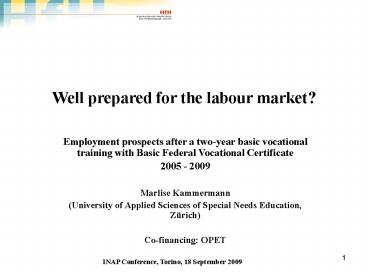Referat BBT, 24'8'09 PowerPoint PPT Presentation
1 / 16
Title: Referat BBT, 24'8'09
1
Well prepared for the labour market?
Employment prospects after a two-year basic
vocational training with Basic Federal Vocational
Certificate 2005 - 2009 Marlise
Kammermann (University of Applied Sciences of
Special Needs Education, Zürich) Co-financing
OPET
INAP Conference, Torino, 18 September 2009
2
Goals for successful transition
- acknowledged certificate of upper secondary
education - high level of skills
- stable and positive employment careers
- equality regarding sex, social background and
region - (OECD, 2000)
3
Difficulties in transition
- young people with a handicap
- young people with low academic achievements
- young people with migration background
- (Imdorf, 2006, 2007 Hupka, Sacchi Stalder,
2006 Bertschy, Böni Meyer, 2007 Lischer,
2007)
4
Vocational Education and Training in Switzerland
Source OPET (2008)
5
elementary VET - basic VET
- elementary training (old)
- Special Needs Education oriented
- individualization
- --- employment prospects
- --- attractiveness
- basic training (new)
- employment prospects
- interchangeability of VET programmes
- individual support
- ?? acceptance
- ?? population
6
Employment prospects and basic VET with Swiss
Federal Vocational Certificate
- Longitudinal study, 2006-2009
- trainees elementary VET und basic VET,
- VET teachers and trainers, employers
- evaluation of the new standardized basic VET
- retail sales and hotel sectors
- comparison with elementary training
7
Research questions
- Employment prospects of young people with Basic
Federal Certificate in comparison to elementary
trainees at the end of VET - Employment prospects of young people with Basic
Federal Certificate in comparison to elementary
trainees one year after completion of VET - Determinant factors for job situation one year
after completion of VET
8
Design
Element.VET
Basic VET
9
Sample elementary VET
per canton und profession (183)
10
Sample basic VET
per canton und profession (N319)
11
Secure prospect at the end of VET
(approximately 2 months before the end of
training)
- elementary VET-trainees (N182)
- Secure professional prospect 47
- secure job 42
- secure VET 12
- Basic VET-trainees (N319)
- Secure professional prospect 45
- secure job 31
- secure VET 26
- Comparison of frequency distribution p lt .05
12
Professional situation one year after completion
of VET (approximately 14 months after the end of
training)
- elementary VET-trainees (N134)
- Secure professional situation 81
- secure job 64
- VET 10
- Basic VET-trainees (N211)
- Secure professional situation 88
- secure job 60
- VET 26
- Comparison of frequency distribution p lt .01
13
Pathway in first year after completion of VET
14
Job situation
15
Employment conditions
16
Salary
17
VET situation
18
Determinants of employment status (logistic
regression)
P lt .01
19
Determinants of employment status (logistic
regression)
P .05
20
Conclusions
- Unsecure prospects at end of VET
- Better permeability to further training for basic
VET - No significant difference regarding employment,
but increased mobility and higher salary for
basic VET - Slow learners are more likely to be without job
- ? basic VET Good solution for the better of the
low achievers
21
Literature
- Bertschy, K., Böni, E. Meyer, T. (2007). An der
zweiten Schwelle Junge Menschen im Übergang
zwischen Ausbildung und Arbeitsmarkt.
Ergebnisbericht des Jugendlängsschnitts TREE,
Update 2007. Bern TREE. - Hupka, S. Sacchi, S. Stalder, B.E. (2006).
Herkunft oder Leistung? Analyse des Eintritts in
eine zertifizierende nachobligatorische
Ausbildung anhand der Daten des
Jugendlängsschnitts TREE. Working Paper. - Imdorf, Ch. (2007). Die Bedeutung
sonderpädagogischer Bildungstitel bei der
Lehrstellenvergabe in KMU. Vierteljahresschrift
für Heilpädagogik und ihre Nachbargebiete, 76(2),
165-167. - Imdorf, Ch. (2006). Der Ausschluss
ausländischer Jugendlicher bei der
Lehrlingsauswahl. Ein Fall von institutioneller
Diskriminierung? Working paper. - Lischer, E. (2007). Perspektiven für den Übergang
von Menschen mit Behinderungen. Länderbericht
Schweiz. In J. Hollenweger, P. Hübner K.
Hasemann (Hrsg.). Behinderungen beim Übergang von
der Schule ins Erwerbsleben. Expertenberichte aus
drei deutschsprachigen Ländern. Zürich Verlag
Pestalozzianum. - OECD (2000). From initial education to working
life. Making transitions work. Paris OECD. - OPET (2008). Facts and Figures. Vocational
Education and Training in Switzerland. Bern OPET.
22
- More information
- www.hfh.ch gt research gt B.5
- contact
- marlise.kammermann_at_hfh.ch

